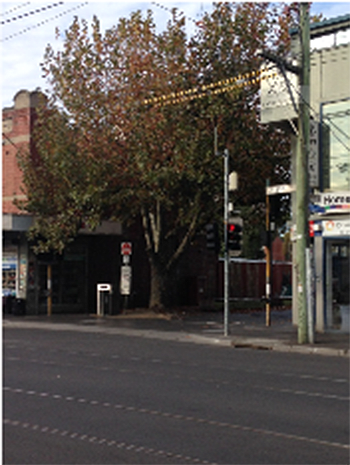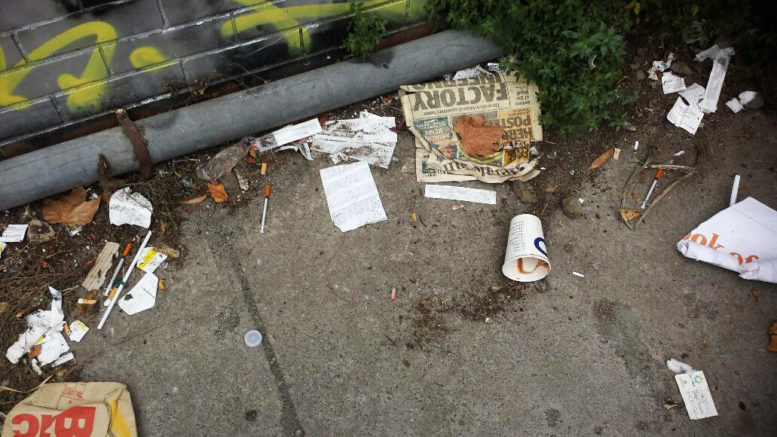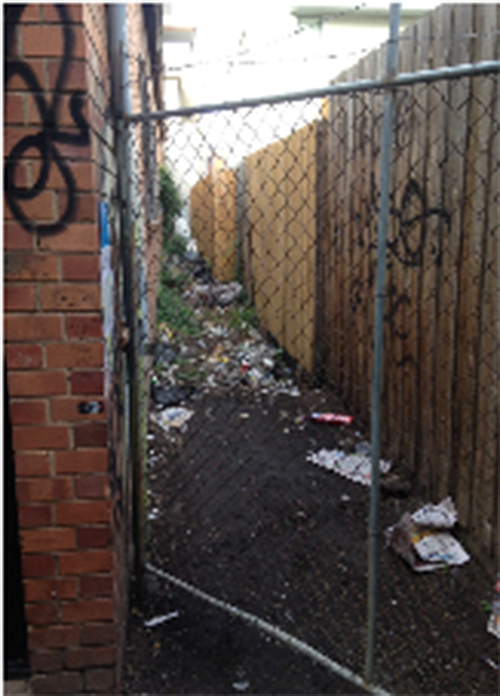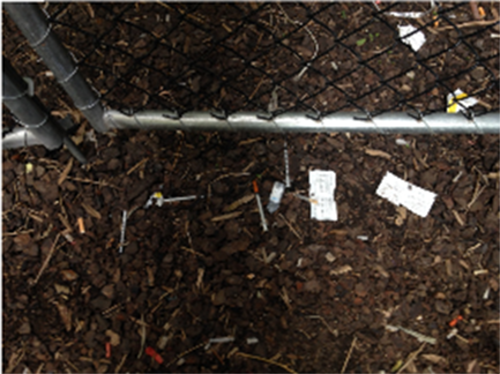Contributed by Adam Andrews
Last year, 170 Victorians were found dead in their communities, their bodies discovered in back alleys, front yards, car parks and even shop fronts. Once thought to be on the decline, heroin addiction is increasingly proving fatal for a growing number of Victorians of all ages.
On the 30th May 2016, a 34-year old mother of two, was found unconscious under the bright lights of a Hoddle Street Hungry Jacks. With a syringe sticking out of her upper leg, and fresh track marks in the groin area, the woman was slumped against the walls of a toilet cubicle. She was rushed to St. Vincent’s Hospital after paramedics failed to gain a response, but died of cardiac arrest only two hours later. First on scene was an employee of the popular Richmond fast-food chain, who now has to live with this image for the rest of their lives.
Mrs. A’s (wishes of the Coroner’s Court to remain anonymous) death sparked an inquiry from The Victorian Coroner Jacqui Hawkins, who called on the Labor Premier Daniel Andrews to establish a supervised injecting room. However, with the rejection from the Andrews Government towards the Coroner’s study, Sex Party MP Fiona Patten moved on the issue and proposed a Bill of her own. Raised to State Parliament in February, an 18-month trial facility as part of North Richmond Community Health, was again rejected.
“How many more people have to die in order to convince Daniel Andrews?” Ms. Patten asked in a recent interview.
The proposed trial facility boasts a multitude of benefits, she says. Not only for the drug users themselves, but for the community of North Richmond.
In 2016, 172 overdose fatalities took place in Victoria, 34 within a single block of North Richmond. The highest since the heroin boom of the 1990’s. This block intersected by Lennox, Victoria, Church and Elizabeth Streets, appears the epicentre for the state’s heroin drug trade and consumption. The spike in public drug use has impacted heavily upon community safety, including petty theft, burglaries, property damage and the heightened aggression of drug users.
Perhaps the biggest danger to public safety is the number of discarded needles that are daily tossed intoublic areas after use. Ms. Patten said that in the crisis area of North Richmond, there are 60,000 syringes given out per year, many of which are used and then left in car parks, playgrounds and gutters. This “needle nightmare” that she refers to is just one of the factors that would be virtually eliminated with th establishment of a supervised injecting room available for drug users.
“The facility will improve the amenity of the area and greatly reduce the amount of drug fuelled encounters that are terrifying residents,” she said.
Support for the facility has been embraced by a vast collection of organisations, including the Australian Medical Association (AMA), Ambulance Victoria and the Salvation Army said Ms. Patten.
“You won’t find any opposition for the facility outside of parliament.”
One doesn’t have to look very far to justify the claims of Ms. Patten’s proposed Bill either. Australia’s only facility, the Medically Supervised Injecting Centre (MSIC) in Sydney’s Kings Cross, flaunts all the benefits of a reformed drug haven. Within the Coroner’s inquiry, a study of the MSIC showed that since it’s opening in 2001, the facility has:
- Successfully managed 6,500 overdoses, without a single death.
- Reduced the number of overdoses in public areas surrounding the facility.
- Reduce the number of ambulance calls outs by 80%.
- Connected over 9,500 people with necessary health and social welfare services.
- Reduced the amount of needles and syringes left in public.
- Gained huge amounts of support from local traders and residents.
In 2010, after a 10-year trial of the facility, The Drug Summit Legislative Response Act 1999 (NSW) was replaced by The Drug Misuse and Trafficking Amendment (Medically Supervised Injecting Centre) Act 2010 (NSW) giving the facility a permanent fixture.
Since Mr. Andrews was appointed Victorian Premier in 2010, there have been 1136 heroin related deaths in the state. Most notably was the 20 per cent increase in heroin related fatalities between 2014-15.
The Premiers critics’ claim current political stance on drug related issues is outdated and counteractive. “Mr. Andrews is worried to be labelled soft on crime,” said Ms. Patten.
The spike in heroin fatalities in recent years is a concern for the community, those who use drugs, but also their families. “There is a moral judgement that the lives of drug users are less important, but what about the lives of their families and friends?” she said.
“We can spend $190,000 a year per person and throw them in prison, or, spend $50,000 and provide necessary life saving rehabilitation.”
“The government has no excuse, they are playing politics with people’s lives.”
Even after being presented with the outstanding research of the MSIC, Mr. Andrews remains clear that there are no future plans to establish a Victorian equivalent. However, given the urgent manner in which the Coroner released her findings earlier this year, and the vastly growing support for Ms. Patten’s Bill, Mr. Andrews has been given until September before proceedings appear in debate once more.
Mayor of the Yarra City Council and major supporter of the Bill, Amanda Stone said that a supervised injecting facility had been part of her policies for 10 years. The Coroner’s inquiry into Drug Law Reform (2017) signified that the Yarra City Council has the highest figure of heroin related deaths across the whole of Victoria. “We have reached crisis point,” said Ms. Stone.
“Residents are scared to come home from work at night because they think there will be a dead body in the driveways,” she said.
Ms. Stone called for a community response in February of this year in order to gather the perspective from the local level. ‘Reimagining Victoria Street’ was designed to gauge local experiences of living, working and visiting Victoria Street and the surrounding areas. The main concern expressed by the community was the hidden dangers that discarded needles pose to the public, especially children. “The police have admitted that they cannot manage the antisocial behaviour and it is leaving the residents feeling completely powerless,” Ms. Stone said.
A North Richmond resident by the name of ‘Ugly’, said that he picks up at least 20 “fits”, more commonly known as syringes, every day from footpaths and other high foot traffic zones. Having lived in North Richmond since 2013, Ugly said the situation has only gotten worse, and is now posing severe threats on the wider community. His grave concern lies heavily around the immediate areas of Boroondara Kindergarten, located on Cooke Court, and West Richmond Primary School on Lennox Street.
He said some of the car parks and pocket parks surrounding these two child learning facilities are used as “unofficial injecting rooms” as Victoria street is becoming less tolerable of such behaviour. Lobbying to the State government for an intense police presence around these schools, Ugly hopes to catalyse the establishment of an absolute no-go zone for drug users.
“It takes a millisecond for a child to pick up what has caught their eye, and that may unfortunately lead to a lifetime of illness,” said Ugly.
“Most of the users have zero sense of social responsibility, why are they getting away with ruining more lives than their own?””Leaving fits on the ground, deliberately or not, is an extremely violent act which needs to be dealt with equivalent force of the law.”
The resident of North Richmond is no stranger to the consequences of these hidden dangers, having experienced needle stick injury whilst cleaning up the footpaths and gutters around his flat. After a year of frightful blood tests, his body seemed to have responded remarkably well, yet the 78-year old now carries surface antigens of Hepatitis A and C.
Another concern for the children of North Richmond is the life lessons they are being taught by a government who are not addressing serious health issues within the community.
“Children see drug paraphernalia and users on the street when they’re in their pushers, when they’re going to kindergarten and when they’re going to and from primary school. Soon enough they will take this is as accepted behaviour,” said Ugly.
“North Richmond needs one legal injecting room rather than 500 unofficial and unsupervised injecting rooms.”
Ugly and other residents implore the Andrews government to seek future Drug Law Reform.
“Drug users think the police are a joke, current laws are failing miserably on a local level.”
And the unresponsive government was leading to the pent up aggression from a large sector of the community, said Ugly.
“There is increasing concerns over the formation of vigilante groups if nothing is seen to be done by Mr. Andrews. Those who are living this drug traumatised lifestyle need their voices heard.”
The trauma and strain of residents living in the area is equally matched among the emergency staff who are called out in the case of an overdose. As previously examined with the MSIC in Kings Cross, which has seen a decrease in 80% of ambulance call outs, the strain upon these individuals is also at crisis point. “I have witnessed up to 14 emergency personnel attend the overdose call out of one person, what an absolutely waste of resources,” Ugly said.
The spokeswoman from North Richmond Community Health (NRCH), Jessie Richardson, said that each overdose response is extremely resource intensive, and can hold hugely traumatic effects on the staff. NRCH is situated on Lennox Street, opposite the community housing flats and West Richmond Primary School. The staff of NRCH are constantly trying to better the medical as well as social conditions of the community, but they are restricted with extremely limited resources and funding said Ms. Richardson.
Those supporting the injecting room trial believe the Andrews Government must respond to the pleas of the North Richmond community and establish the proposed supervised injecting room in the near future. Residents, traders and visitors are living a traumatised existence in this area of crisis. With undeniable research and such positive results coming from the MSIC trial in Kings Cross, there is no excuse anymore. It is not a matter of being ‘tough on crime’, as these ideals have proven to be severely fatal. The community deserves answers Mr. Andrews, there cannot be another life wasted just so the State’s political agenda can be satisfied.
 The Victoria and Lennox Street intersection is often plagued with drug related behaviour
The Victoria and Lennox Street intersection is often plagued with drug related behaviour
One of the many ‘unofficial’ injecting rooms throughout the suburb
Syringes and other drug paraphernalia scatter through local playgrounds




Be the first to comment on "Through the eye of a needle in North Richmond"